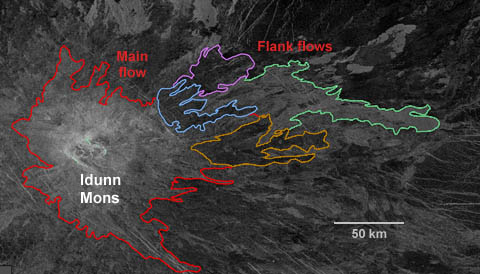Planetary scientists haven't yet witnessed an active volcano on Venus, but a new study pinpoints a likely set of still-warm lava flows.
If ancient skywatchers knew what we know now, they might have decided to pick Hades over Venus as the name for Earth's closest planetary neighbor. This cloud-covered world has a dense carbon-dioxide atmosphere laced with sulfuric acid, registers a blistering 460°C (860°F) at ground level, and sports roughly 1,100 volcanic features that cover about 85% of its surface.

NASA / JPL and ESA
Planetary scientists have little doubt that volcanic eruptions continue on Venus even now. Although they haven't been able to prove it, there've been no shortage of "smoking guns": NASA's Magellan orbiter used radar to map the surface in the early 1990s and found lots of fresh-looking flows. ESA's Venus Express found several hot spots that came and went. And both Venus Express and NASA's Pioneer Venus Orbiter detected surges in the atmosphere's level of sulfur dioxide (SO2), a gas likely released during eruptions.
Now a new study has combined these spacecraft observations of Idunn Mons, a massive volcano in the planet's southern hemisphere that's about 200 km across and 2½ km tall. In 2006 and 2007, the ESA orbiter's Visible and Infrared Thermal Imaging Spectrometer (VIRTIS) detected excess heat coming from the eastern flank of Idunn Mons, but the atmosphere's opaque clouds blocked the view from orbit.

NASA / ESA / DLR
A team led by Piero D’Incecco (German Aerospace Center, Cologne) dove into the Magellan archives to identify some high-resolution radar maps of Idunn Mons. "We really pushed the resolution of the Magellan and Venus Express data sets to get this result," D’Incecco says.
They identified five distinct lava flows: an extensive one that blankets the summit, and four others that trail down the mountain's eastern flank. They all look fresh, but could they be recent enough to explain the warm ground detected by VIRTIS?
The team first modeled how much heat could be radiating from each flow, then found that a combination of three of flows on the eastern flank (outlined with purple, blue, and tan in the map above) matches the heat distribution best. As an independent check, these flank flows appear to be superimposed on other slope features, suggesting that they're the most recent additions.
D’Incecco reported these findings yesterday at a joint meeting of the AAS's Division for Planetary Science and the European Planetary Science Congress, now taking place in Pasadena, California.
So what will it take to prove that volcanoes on Venus continue to spout off? More capable spacecraft — and luck. Some European planetary specialists hope to launch an orbiter called EnVision in 2025, while on this side of the Atlantic a team has proposed an orbiter called Veritas (short for Venus Emissivity, Radio Science, InSAR, Topography, and Spectroscopy) that could start high-resolution radar mapping in 2021.
 0
0
Comments
You must be logged in to post a comment.